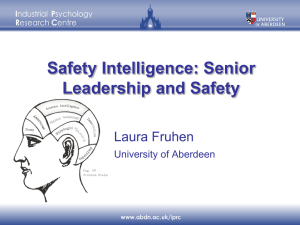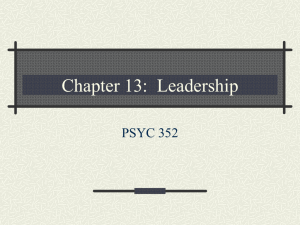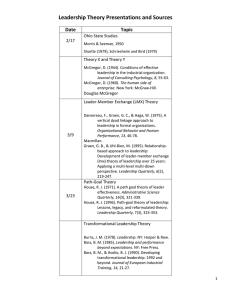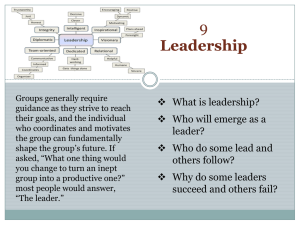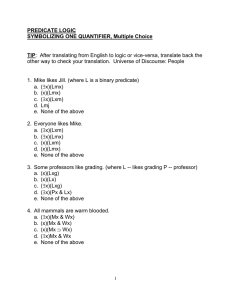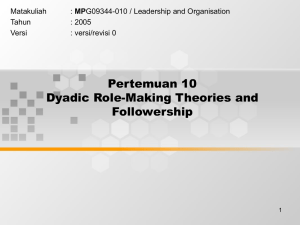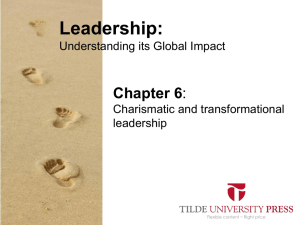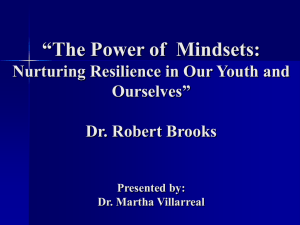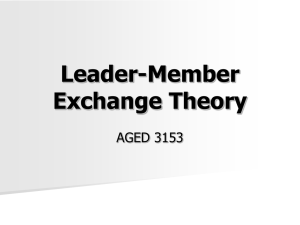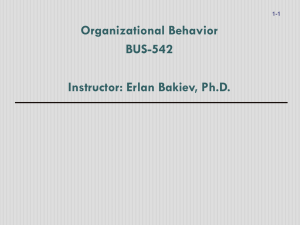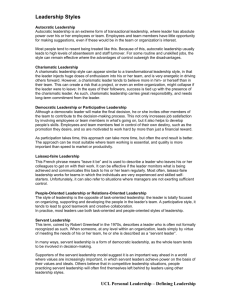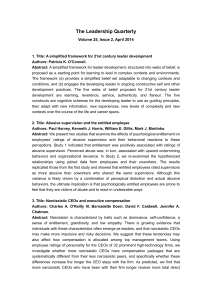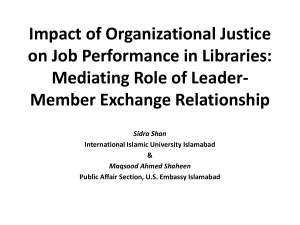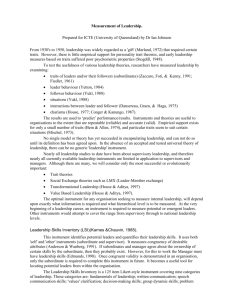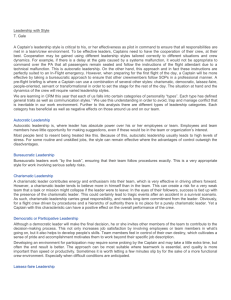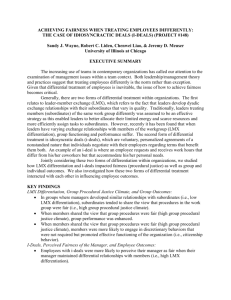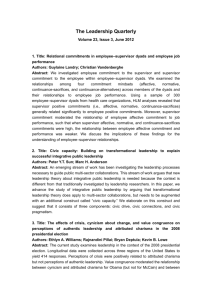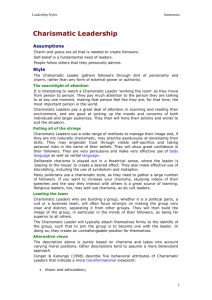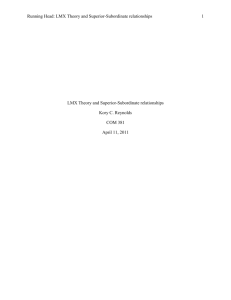CHAPTER 12: LEADERSHIP
advertisement
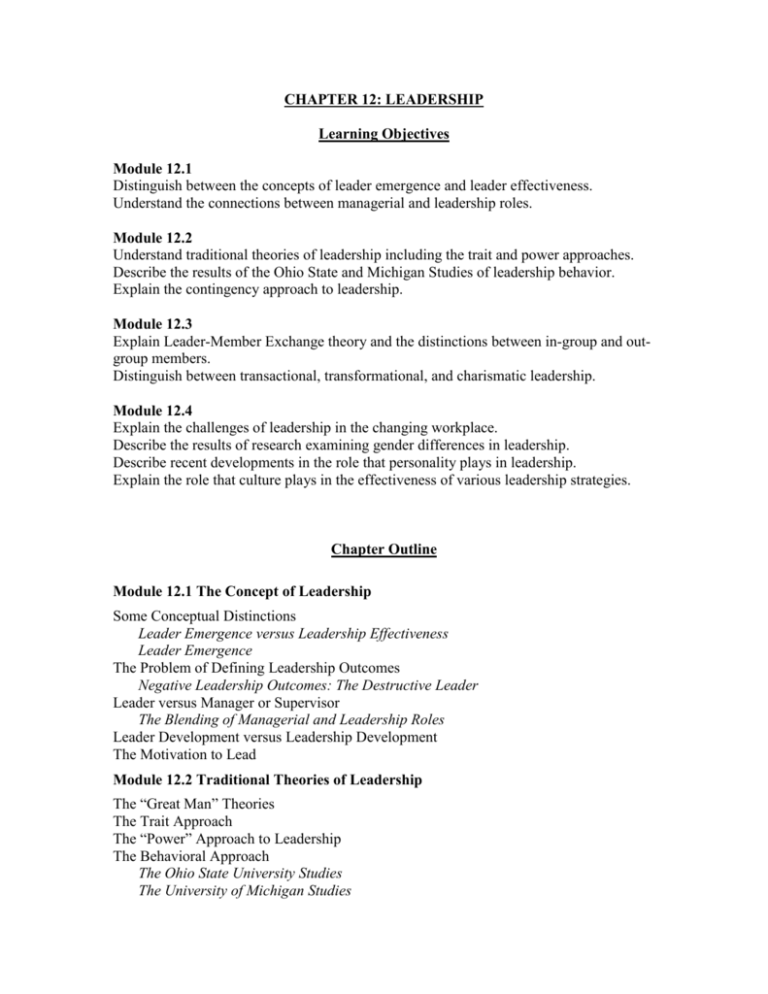
CHAPTER 12: LEADERSHIP Learning Objectives Module 12.1 Distinguish between the concepts of leader emergence and leader effectiveness. Understand the connections between managerial and leadership roles. Module 12.2 Understand traditional theories of leadership including the trait and power approaches. Describe the results of the Ohio State and Michigan Studies of leadership behavior. Explain the contingency approach to leadership. Module 12.3 Explain Leader-Member Exchange theory and the distinctions between in-group and outgroup members. Distinguish between transactional, transformational, and charismatic leadership. Module 12.4 Explain the challenges of leadership in the changing workplace. Describe the results of research examining gender differences in leadership. Describe recent developments in the role that personality plays in leadership. Explain the role that culture plays in the effectiveness of various leadership strategies. Chapter Outline Module 12.1 The Concept of Leadership Some Conceptual Distinctions Leader Emergence versus Leadership Effectiveness Leader Emergence The Problem of Defining Leadership Outcomes Negative Leadership Outcomes: The Destructive Leader Leader versus Manager or Supervisor The Blending of Managerial and Leadership Roles Leader Development versus Leadership Development The Motivation to Lead Module 12.2 Traditional Theories of Leadership The “Great Man” Theories The Trait Approach The “Power” Approach to Leadership The Behavioral Approach The Ohio State University Studies The University of Michigan Studies The Contingency Approach Hersey and Blanchard’s Situational Theory The Consequences of Participation: The Vroom–Yetton Model Module 12.3 New Approaches to Leadership Leader–Member Exchange (LMX) Transformational Leadership Authentic Leadership The Charismatic Leader Module 12.4 Emerging Topics and Challenges in Leadership Research Leadership in a Changing Workplace Male and Female Leaders: Are They Different? The Demographics of Leadership The Leadership Styles of Men and Women Personality and Leadership Cross-Cultural Studies of Leadership Leadership in a Diverse Environment Guidelines for Effective Leadership Glossary Terms for Chapter 12 This list of key terms and important concepts from Chapter 12 can be used in conjunction with reviewing the material in the textbook. After reviewing Chapter 12 in the textbook, define each of the following key terms and important concepts fully. Check your answers with the textbook, and review terms with which you have difficulty. Good luck! Module 12.1 leader emergence leadership effectiveness leader attempted leadership successful leadership effective leadership leader development leadership development interpersonal competence power motive activity inhibition affiliation need Module 12.2 “Great Man” Theories trait approach power approach behavioral approach consideration initiating structure task-oriented behavior relations-oriented behavior participative behavior contingency approach job maturity psychological maturity Module 12.3 Leader-Member Exchange (LMX) theory in-group members out-group members "life-cycle" of a leader-follower relationship transformational leadership transactional leadership idealized influence inspirational motivation intellectual stimulation laissez-faire leadership full-range theory of leadership Multifactor Leadership Questionnaire (MLQ) charisma charismatic leader charismatic leadership theory Module 12.4 virtual team Global Leadership and Organizational Behavior Effectiveness (GLOBE) culture-specific characteristics Class Ideas for Chapter 12 1. The Industrial-Organizational Psychologist (TIP) articles of interest: Graen, G.B. (January 2009). 9-11-08 Crash: I-O psychology can help. The IndustrialOrganizational Psychologist, 46 (3), 35-37. (Article discusses LMX leadership) Madigan, J., & Marcus W. Dickson, M.W. (January 2009). Good science-good practice. The Industrial-Organizational Psychologist, 46 (3), 57-61. (Article discusses recent research on ethical leadership) Rousseau D. M., (January 2009). I-O psychologists at the leading edge of evidence-based management. The Industrial-Organizational Psychologist, 46 (3), 11-14. Debate Topics: - Which Big 5 characteristic do you think most strongly correlates with leadership effectiveness? How influential is “charisma” on perceptions of leadership effectiveness? Critical Thinking Exercises (CTEs) 12.1 Every four years, the United States chooses a president. The campaign for the presidency often lasts for two years or more. Would you characterize the enventual election of a president as an example of leader effectiveness or leader emergence? Why? 12.2 We have seen that there may be many different, and sometimes competing, motives to lead. Using the Chan and Drasgow (2001) trichotomy of motives to lead, would a university be better served with a president who is driven predominantly by an affectiveidentity motive, an instrumental motive, or a social-normative motive? Why? 12.3 In the new world of the global economy and the multinational organization, which of the following methods of exercising formal power or authority might be the most effective for a CEO of a multinational software company? Why? 1. Forming coalitions 2. Controlling important decisions 3. Co-opting the opposition 4. Controlling information flow 12.4 Facing bankruptcy, an international airline is considering radically altering the nature of its service in order to increase revenues. The airline proposes transforming itself from one catering to elite travelers to one with no frills. The CEO is considering asking all employees, including flight attendants, mechanics, pilots, and administrative staff, to join in the ultimate decision. Using flight attendants as your example, which decision model would you recommend to the CEO for including this group of employees in the decision? Why? Consider the Vroom-Yetton model and the decision tree that appears in Table 12.5 and Figure 12.5 in choosing a solution. The “Great Man/Great Woman” theory of leadership is attractive but has not been supported by scientific research. 12.5 In some organizations, closeness to a supervisor or leader is ridiculed by fellow workers. This presents a dilemma for the leader intent on developing high-quality LMX relationships. If you were that leader, how would you go about creating a high-quality LMX work environment? 12.6 The plant manager of an electronics manufacturing company is fiercely loyal to his employees. The workers know that if there is ever any problem with payroll or benefits, they can come to him and he will fight for them against the human resources department. When the training department presented on-site workshops on the use of spreadsheets and quality assurance software, the manager arranged to get waivers for his managers so they would not have to waste their time in classes. Would you classify this plant manager as a transformational leader, a charismatic leader, or neither? Explain your answer. 12.7 In the new virtual work environment characterized by dispersed work teams and telecommuting, which of the following leadership approaches would be most difficult to implement? Why? Which would be easiest? Why? 1. LMX 2. Transactional 3. Transformational 4. Path-goal 12.8 A woman friend of yours who has never filled a formal management role before tells you that she had just been chosen to replace a departing manager. She asks you if, as a female leader, she should adopt a style different from her departing male counterpart. What would you advise her?

